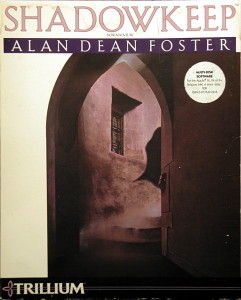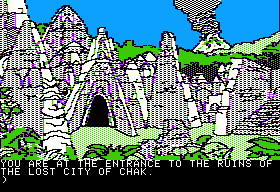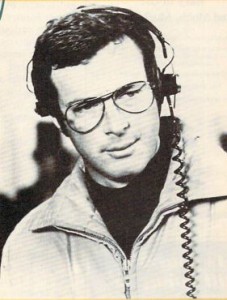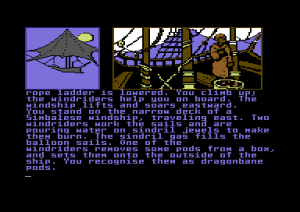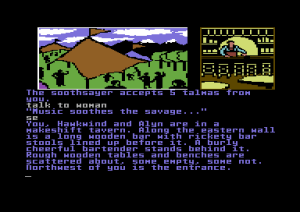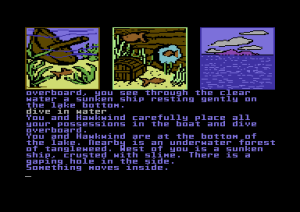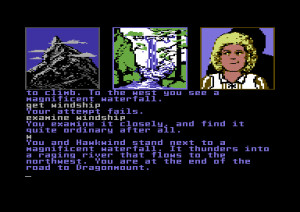The story of Shadowkeep, even more so than Amazon the odd duck in the Telarium lineup, begins with Sigma Distributing, one of the first big microcomputer hardware distributors in the Seattle area. In 1981 Christopher Anson, a Sigma vice president, sought and received permission to start a new subsidiary to develop original games to serve the growing demand for software for the computers Sigma was selling. Anson’s first two acts were to name the company Ultrasoft and hire a programmer named Alan Clark away from Boeing. Clark became the technical architect of the set of tools and approaches that would define Ultrasoft during their brief existence.
Anson had decided that the best place for Ultrasoft to make a splash was in the field of illustrated adventure games, a nexus of excitement in the wake of Mystery House and The Wizard and the Princess. Like Scott Adams, Ken Williams, and Marc Blank before him, Clark realized that it would be more efficient in the long run to write an adventure-game engine and language that could give designers a bit of distance from the technical details of implementation as well as let Ultrasoft deploy their games to multiple platforms relatively painlessly. Deciding that a little corporate branding is always in order, they named their adventure programming language simply Ultra; the interpreter for each targeted platform UltraCode; their graphics system UltraVision. From the standpoint of the end user, Ultrasoft’s most obvious innovation — or, if you like, gimmick — involved this last. UltraVision could display not just static pictures but also brief animations, which could be used to, say, show the player’s avatar actually walking from room to room. Less obvious but no less significant, however, was the parser, one of the first developed outside of Infocom that allowed more than two words — although, it should be said, it was nowhere near as impressive a creation overall (more on that shortly).
Ultrasoft developed two adventures using the system, The Mask of the Sun (1982) and Serpent’s Star (1983). Both are interesting in their way, more carefully crafted, atmospheric, and thoughtful than was the norm of the time. Serpent’s Star in particular does a surprisingly good job of matching its puzzles to its theme of Buddhist philosophy. But both — and particularly Mask of the Sun — are also riddled with the sorts of unfair elements that were all too typical of their era. And both are fairly excruciating to play under any conditions. Whatever its other merits, you see, the Ultra system is slow. A quick look at the games’ technical underpinnings gives a clue as to why: the Ultra program logic doesn’t appear to be compiled at all, merely interpreted in place. The only blessing of that approach was that it enabled some frustrated adventurers to find the solutions to the more incomprehensible puzzles by code diving.
Ultrasoft first tried to market and distribute Mask of the Sun and Serpent’s Star on their own, but found it tough sledding for a tiny company with mainly regional connections in the professionalizing software industry of 1983. They soon accepted the role of developer only, licensing both games to Brøderbund for publication. After spending most of 1983 working on an ambitious new game, an adventure-game/CRPG hybrid called Shadowkeep written in a new version of their system which they dubbed Ultra II, they found a publisher for it in Spinnaker, who took the largely completed game as a future member of their planned Telarium line.
Looking to find some way to make the game fit with the bookware theme of the line as a whole, Spinnaker came up with the idea of reversing the usual process, of hiring a name writer to adapt the game into a book rather than the opposite. Luckily, they had substantial time to get the novelization done; they signed the contract with Ultrasoft in late 1983, a year before they planned to launch the Telarium line. Spinnaker approached Warner Books, who hooked them up with the reigning king of media tie-in novels, Alan Dean Foster. After making his reputation within the industry ghost-writing the Star Wars novelization for George Lucas, Foster had gone on to do The Black Hole, Clash of the Titans, The Last Starfighter, and Alien among many others. Virtually any big science-fiction or fantasy movie released seemed to arrive with an accompanying Alan Dean Foster novelization. (That’s still true today; his most recent novelization as of this writing is of Star Trek into Darkness.)
Spinnaker furnished Foster with design documents and a copy of the Shadowkeep source code and let him have at it. Those were all he had to go on; he doesn’t recall ever meeting or speaking with anyone from the design team, nor ever actually playing the game. He does, however, recall it as a very challenging project indeed. Being a party-based CRPG in the mold of Wizardry, Shadowkeep has no actual protagonist to speak of — no characters at all, really, outside of the fellow who sells you equipment and the evil demon Dal’Brad who shows up for the final showdown on the last of the dungeon levels. He was thus forced to invent the vast majority of the novel himself, whilst struggling to strike a balance between writing some recognizable analogue to the experience of the game and giving away all of its challenges. He did his usual workmanlike job, handing in a readable little genre exercise for simultaneous release with the game. Tellingly, it’s not until halfway through the book that the heroes enter the Shadowkeep — i.e., reach the beginning of the game.
Said game is… well, it’s really strange. Imagine Wizardry played with a text parser, and you’ve pretty well summed up Shadowkeep. You make a party of up to nine(!) characters. Most of the usual is here: attribute scores, classes and races to choose from, ever better equipment and spells to collect. Oddly missing, however, are character levels and any concept of experience; getting more powerful in this game is strictly a matter of finding or buying better stuff. The dungeon levels are the usual 16 X 16 grids full of traps, monsters, and assorted cartographic challenges. There are some original ideas here. For instance, the positions of the monsters that attack you and those of the members of your party are taken account of to a degree not found in Wizardry, adding some strategic depth to the experience. You likewise have more combat options than in Wizardry; in each round you can choose to forget defense and attack twice, or to just parry, or to attack once while not totally neglecting defense. And certainly the full-color graphics, which feature occasional examples of Ultrasoft’s trademark animations, are much better than Wizardry‘s wire frames.
Still, Shadowkeep mostly just makes you appreciate all the more how well Wizardry does the dungeon crawl. The game replaces Wizardry‘s hot-key interface with, yes, a text-adventure parser. You literally just type what you want to do: “OPEN DOOR,” “GET THE TORCH,” “CAST THE LUMINANCE SPELL,” “LIGHT THE TORCH AND PREPARE THE SWORD,” “PUT THE WAND OF TRAVEL IN THE CHEST.” Sounds fine, right? Well, what sounds fine in the abstract doesn’t work so well in practice. You must now type “F <RETURN>” (for “FORWARD”) instead of just “F” every time you want to walk forward a square in the dungeon. This may seem a minor thing, but consider that you’ll be entering this command thousands and thousands of times in the course of playing the game. That extra keystroke thus means thousands and thousands of extra keystrokes. And that’s the tip of the iceberg; this game is death by a hundred such small cuts. Commands by default are carried out by the leader of your party, who is not even a character you select but merely the one with the highest Leadership attribute score. Having someone else do something requires that you prepend her name to the command (“NAOMI GET THE TORCH AND GIVE IT TO REB”) — yet more tedious typing.
And the parser, that focal point of the whole interface, is at least as exasperating as the mainline Telarium parser. Like Byron Preiss Video Productions and many others at this time, Ultrasoft chose to take a profoundly misguided approach to this most critical piece of their engine. As described in an article in Softline magazine:
Ultrasoft’s parser is based on concepts in artificial intelligence. In any given message, it eliminates words that don’t make sense and attempts to make sense out of words that are relevant to the situation. This method frees the player from the verb-noun format of the typical adventure’s input.
In other words, the parser pretends to be smarter than it is by simply throwing out anything it doesn’t understand and doing what it can with the rest. This approach may “free the player from the verb-noun format,” but it also guarantees that complex (and often not so complex) inputs will be not just rejected — which combined with a proper error message is at least a form of useful feedback — but misunderstood. Far from making the parser seem smarter, this just makes it seem that much dumber and that much more infuriating. It leads to situations like that in the Byron Preiss games where any input containing the word “LOOK” anywhere within it causes the parser to dump everything else and print a room description. In Shadowkeep, typing “NAOMI CAST CURE SPELL ON REB” leads her to cast it away into the ether — that “ON REB” was a bridge too far, and thus ignored. Such a system fails to recognize that at least 95% of the time those extra words are not just stuff the player tacked on for the hell of it (who wants to type more than necessary under any circumstances?) but essential information about what she really wants to do.
To play Shadowkeep is to constantly wrestle with the interface. After playing several hours there are basic tasks I still haven’t figured out how to do — like how to cast a cure spell on someone outside of combat, or how to just get a list of the spells a certain character knows. And, like Ultrasoft’s earlier games, Shadowkeep is slow. Every step in the dungeon seems to take an eternity, and as for more complex action… forget about it. Playing is like wading through molasses with shackled feet.
The rewards for all the parsing pain are relatively slight: a handful of logic- or object-oriented puzzles on each level that can perhaps be a bit more complex than they could be under the Wizardry engine. Needless to say, they aren’t worth the rest of the trouble, making Shadowkeep something of a lowlight in the long, chequered history of adventure/CRPG hybrids. Which is a shame, because Shadowkeep‘s dungeon levels do show evidence of some careful craftsmanship and, as noted above, there are some good, original ideas on display here. Shadowkeep is a perfect example of a potentially worthy game destroyed by horrid interface choices. And I mean that literally: if the game isn’t outright unplayable (some patient souls have apparently played and even enjoyed it), it’s closer than I ever need to come to that adjective.
Ultrasoft was already in the process of fading quietly away by the time of Shadowkeep‘s late 1984 release. They never managed to port the Ultra II engine beyond the Apple II, leaving Shadowkeep without that all-critical Commodore 64 version. Spinnaker toyed with doing the port themselves, even announcing it as coming soon on various occasions, but I see no reason to believe that ever happened. (A Commodore 64 version has been a semi-mythical White Whale in collecting circles for many years now, but, despite some anecdotal claims and remembrances, no one has ever produced an actual working version to my knowledge.) The lack of a Commodore 64 version and the underwhelming nature of the game itself combined to make Shadowkeep the least successful — and, today, rarest — of all the Telarium games. Alan Dean Foster’s book, while no bestseller itself, appears to have sold far more copies on the author’s name recognition and its $3 (as opposed to $35) price tag.
Shadowkeep consists, like most of the Telarium games, of four disk sides. In this case, however, all four sides are written to during play to preserve the current state of the dungeon levels; the player is expected to copy her originals before beginning. Most of the copies floating around the Internet contain the residue of the previous players in their dungeons. Thankfully, however, reader Peter Ferrie has provided me (and thus you) with a completely pristine set just waiting for you and only you to leave your marks upon them. If whilst playing Wizardry or Bard’s Tale you thought to yourself that this game would be even better if it played a lot slower and had a parser, you’ve just found your dream CRPG. All others should consider this one a subject for historical research only.
And on that less than stellar note we’ll be moving on from Telarium for a while. My final reckoning of their first five releases is: two worthy efforts (Dragonworld and Amazon); one could-have-been-a-contender (Fahrenheit 451); and two total misfires (Rendezvous with Rama and Shadowkeep). Not a horrible track record on the whole. We’ll see if they learned any lessons in time for their last few games down the road a ways. But next it’s time to get back to the big boys in the field, and tell the rest of the story of Infocom’s very eventful 1984.
(In addition to the sources listed in my first article on bookware and Telarium, I also referenced for this article a feature on Ultrasoft in the May/June 1983 Softline. And thanks to Alan Dean Foster for taking the time to share his memories of the Shadowkeep project with me.)
